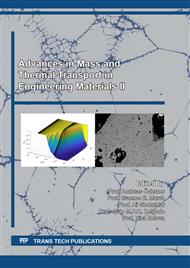[1]
U. Balucani and M. Zoppi, Dynamics of the liquid state. Clarendon Press, New York, (1994).
Google Scholar
[2]
A. Meyer and F. Kargl, Diffusion of Mass in Liquid Metals and Alloys-Recent Experimental Developments and New Perspectives,, Int. J. Microgravity Sci. Appl, vol. 30, no. 1, pp.30-35, (2013).
Google Scholar
[3]
K. Binder and W. Kob, Glassy materials and disordered solids: An introduction to their statistical mechanics. World scientific Publishing Co. Pte. Ltd., Singapore, (2011).
DOI: 10.1142/7300
Google Scholar
[4]
R. Heringer, C.-A. Gandin, G. Lesoult, and H. Henein, Atomized droplet solidification as an equiaxed growth model,, Acta materialia, vol. 54, no. 17, pp.4427-4440, (2006).
DOI: 10.1016/j.actamat.2006.05.015
Google Scholar
[5]
M. Rappaz and W. J. Boettinger, On dendritic solidification of multicomponent alloys with unequal liquid diffusion coefficients,, Acta Materialia, vol. 47, no. 11, pp.3205-3219, (1999).
DOI: 10.1016/s1359-6454(99)00188-3
Google Scholar
[6]
A. D. Le Claire, Physical Chemistry, (Solid State). Academic Press, New York, (1970).
Google Scholar
[7]
P. Kuhn, and J. Horbach, F. Kargl, A. Meyer and Th. Voigtmann, (2014) Diffusion and interdiffusion in binary metallic melts,, Physical Review B, 90, 024309.
DOI: 10.1103/physrevb.90.024309
Google Scholar
[8]
E. Sondermann, F. Kargl and A. Meyer, (2016) Influence of cross correlations on interdiffusion in Al-rich Al-Ni melts. Physical Review B, 93 (18), p.184201.
DOI: 10.1103/physrevb.93.184201
Google Scholar
[9]
N. L. Peterson, Isotope Effects in Diffusion,, in: Diffusion in Solids. Recent Developments, Eds A.S. Nowick and J.J. Burton, Academic Press, 1975, New York, San Francisco, London.
Google Scholar
[10]
H. Mehrer, Diffusion in Solids: Fundamentals, Methods, Materials, Diffusion-Controlled Processes, Vol. 155 of Springer Series in Solid-State Sciences, 2007, Springer Science & Business Media, Berlin Heidelberg.
DOI: 10.1007/978-3-540-71488-0
Google Scholar
[11]
U. Sarder, A. V. Evteev, E. V. Levchenko, A. Kromik, I. V. Belova, and G. E. Murch, Molecular Dynamics Study of Mass Transport Properties of Liquid Cu-Ag Alloys,, Diffusion Foundations, vol. 9, pp.58-72, (2016).
DOI: 10.4028/www.scientific.net/df.9.58
Google Scholar
[12]
U. Sarder, Modelling of Thermotransport in Engineering Materials,, PhD Dissertation, Mechanical Engineering, University of Newcastle, (2019).
Google Scholar
[13]
R. J. Bearman and D. L. Jolly, Mass dependence of the self diffusion coefficients in two equimolar binary liquid Lennard-Jones systems determined through molecular dynamics simulation,, Molecular Physics, vol. 44, no. 3, pp.665-675, (1981).
DOI: 10.1080/00268978100102711
Google Scholar
[14]
R. J. Bearman and D. L. Jolly, Molecular dynamics simulations of self-diffusion coefficients in binary isotopic Lennard-Jones solutions: Comparison with experimental data on isotope effects in benzene diffusion,, Molecular Physics, vol. 52, no. 2, pp.447-460, (1984).
DOI: 10.1080/00268978400101321
Google Scholar
[15]
B. J. Alder, W. E. Alley, and J. H. Dymond, Studies in molecular dynamics. XIV. Mass and size dependence of the binary diffusion coefficient,, The Journal of Chemical Physics, vol. 61, no. 4, pp.1415-1420, (1974).
DOI: 10.1063/1.1682067
Google Scholar
[16]
P. Schofield, Computer simulation studies of the liquid state,, Computer physics communications, vol. 5, no. 1, pp.17-23, (1973).
Google Scholar
[17]
I. Ebbsjo, I. Waller, P. Schofield, and K. Skold, Diffusion in liquid mixtures of isotopes,, Journal of Physics C: Solid State Physics, vol. 7, no. 21, p.3891, (1974).
DOI: 10.1088/0022-3719/7/21/011
Google Scholar
[18]
N. Kiriushcheva and S. V. Kuzmin, Influence of mass difference on dynamic properties of isotope mixtures,, Physica A: Statistical Mechanics and its Applications, vol. 352, no. 2-4, pp.509-521, (2005).
DOI: 10.1016/j.physa.2005.01.010
Google Scholar
[19]
U. Sarder, T. Ahmed, W. Y. Wang, R. Kozubski, Z.-K. Liu, I. V. Belova, and G. E. Murch, Mass and thermal transport in liquid Cu-Ag alloys,, Philosophical Magazine, pp.1-24, (2018).
DOI: 10.1080/14786435.2018.1546958
Google Scholar
[20]
I. V. Belova, T. Ahmed, U. Sarder, W. Y. Wang, R. Kozubski, Z.-K. Liu, D. Holland-Moritz, A. Meyer, and G. E. Murch, Computer simulation of thermodynamic factors in Ni-Al and Cu-Ag liquid alloys,, Computational Materials Science, vol. 166, pp.124-135, (2019).
DOI: 10.1016/j.commatsci.2019.04.048
Google Scholar
[21]
P. Williams, Y. Mishin, and J. Hamilton, An embedded-atom potential for the Cu–Ag system,, Modelling and Simulation in Materials Science and Engineering, vol. 14(5), pp.817-833, (2006).
DOI: 10.1088/0965-0393/14/5/002
Google Scholar
[22]
F. Fischer , G. Schmitz, S.M. Eich, A systematic study of grain boundary segregation and grain boundary formation energy using a new copperenickel embedded-atom potential, Acta Materialia, 176 (2019) 220-231.
DOI: 10.1016/j.actamat.2019.06.027
Google Scholar
[23]
S. Chapman, T. G. Cowling, and D. Burnett, The mathematical theory of non-uniform gases: an account of the kinetic theory of viscosity, thermal conduction and diffusion in gases, 3rd ed. Cambridge university press, New York, (1990).
DOI: 10.2307/3609795
Google Scholar
[24]
A. H. Schoen, Correlation and the isotope effect for diffusion in crystalline solids,, Physical Review Letters, vol. 1, no. 4, p.138, (1958).
Google Scholar
[25]
H. R. Schober, Isotope effect in the diffusion of binary liquids,, Solid state communications, vol. 119, no. 2, pp.73-77, (2001).
DOI: 10.1016/s0038-1098(01)00219-8
Google Scholar
[26]
W.Y. Wang, H.Z. Fang, S.L. Shang, H.Zhang, Y.Wang, X.Hui, S.Mathaudhu, Z.K. Liu, Atomic structure and diffusivity in liquid Al80Ni20 by ab initio molecular dynamics simulations, Physica B: Condensed Matter, 406 (2011) pp.3089-3097.
DOI: 10.1016/j.physb.2011.05.013
Google Scholar


